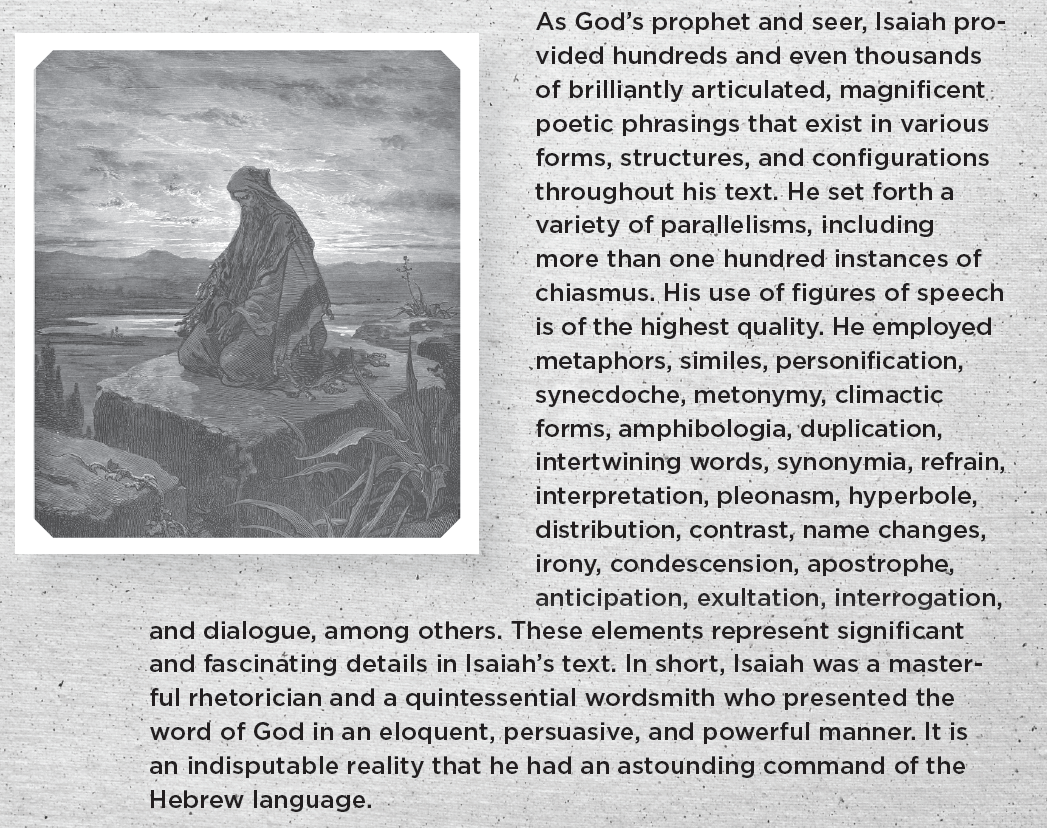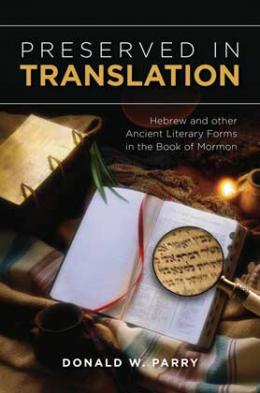Symbolic Action as Prophetic Curse
Donald W. Perry, “Symbolic Action as Prophetic Curse,” in Preserved in Translation: Hebrew and Other Ancient Literary Forms in the Book of Mormon (Provo, UT: Religious Studies Center, Brigham Young University; Salt Lake City: Deseret Book), 75‒80.
"walking naked and barefoot" (Isaiah 20:2)
At one point during Isaiah’s ministry, the Lord instructed Isaiah, “Go and loose the sackcloth from off thy loins, and put off thy shoe from thy foot. And he did so, walking naked and barefoot” (Isaiah 20:2). This symbolic action by Isaiah represented a prophetic curse that destruction and ruin would come upon the Egyptians. Just as Isaiah walked naked and barefoot, as did slaves in his day, even so would the Egyptians become slaves to the Assyrians (see Isaiah 20:2–4).
Ezekiel also performed a symbolic action as a prophetic curse. He cut off the hair of his beard and his head and divided the hair into three portions. Ezekiel then burned one-third of his hair, cast a second third into the wind, and smote the last third with a knife. This prophetic curse demonstrated the three ways that Israel would perish—by fire, by scattering, and by the sword of war (see Ezekiel 5:1–17). Jeremiah likewise enacted a symbolic action as a prophecy. He broke a potter’s vessel at Jerusalem’s east gate while men of the city watched (see Jeremiah 19). This symbolic action was a visual prophecy that Jerusalem’s inhabitants would be destroyed as completely as was the vessel.
Such symbolic actions as prophetic curses are found repeatedly in the Bible.[1] Table 1 illustrates several instances, most of which come from the books of Jeremiah and Ezekiel.
Object of Action | Symbolic Action as Curse | Interpretation of the Action |
Garment (1 Kgs. 11:29–31) | Ahijah rips a garment into twelve pieces and gives ten pieces to Jeroboam | The united kingdom of Israel will be divided, and Jeroboam will rule over ten of the tribes |
Linen girdle (Jer. 13:1–10) | Jeremiah wears a linen girdle and then hides it in the hole of a rock | Judah, which was once whole like the linen girdle, will become rotten like the girdle that was placed in the earth |
No marriage or children (Jer. 16:1–12) | Jeremiah is commanded to refrain from marrying, having children, and feasting in a joyous manner | Israel will be destroyed, not enjoy familial relations, and be unable to mourn for the loss of family life |
Potter’s vessel (Jer. 19) | Jeremiah breaks a vessel in the presence of men near Jerusalem’s east gate | The people will be broken and destroyed |
Yoke (Jer. 27–28) | Jeremiah makes yokes, places one around his neck, and sends the remaining yokes to neighboring kings | The kings and kingdoms who do not submit to the governance of Nebuchadnezzar will be destroyed |
Book (Jer. 51:58–64) | Jeremiah writes in a book about evil that will come upon Babylon, ties the book to a stone, and throws it into the Euphrates | Evil and destruction will come upon Babylon, which will sink and not rise again |
Scroll (Ezek. 2:8–3:6) | Ezekiel eats a scroll | Just as the eaten scroll contains lamentations, mourning, and woe, so Ezekiel’s prophecies will consist of lamentations, mourning, and woe |
Clay tile (Ezek. 4:1–3) | Ezekiel draws a picture of Jerusalem and a siege with mounds and battering rams | Jerusalem will be besieged by an army that will build mounds and use battering rams to break through the wall and take the city captive |
Bread, water, and dung (Ezek. 4:9–17) | Ezekiel bakes bread with dung in it, eats measured portions of it, and drinks measured portions of water | As a curse because of their sinfulness, Israel will eat defiled bread among the Gentiles, and bread and water will become scarce to Israel |
Ezekiel’s belongings (Ezek. 12:1–16) | Ezekiel packs his bags and goes forth from his home | The children of Israel will pack their personal effects and be led away captive to Babylonia |
Food and drink (Ezek. 12:17–20) | Ezekiel trembles as he eats and drinks | Israel’s land will be stripped of its produce, and Israel will eat and drink with great trembling because of fear |
Ezekiel (Ezek. 21:6–7) | Ezekiel sighs, groans, and beats his breast | Bad news is coming that will cause Israel to fear and to become weak-hearted |
Sword (Ezek. 21:8–17) | Ezekiel makes slashing movements with a sword | In every direction that Ezekiel slashes with the sword, the Lord will cause slaughter upon Israel |
Wife of Ezekiel (Ezek. 24:15–24) | Ezekiel’s wife dies, and he does not mourn for her | Just as Ezekiel does not mourn the loss of his wife, so the children of Israel will not be permitted to mourn the loss of their loved ones, whom they will lose during wars and tribulations |
Table 1. Biblical instances of symbolic actions as prophetic curses
Dramatic acts capture the attention of the prophets’ audiences, appealing to both the ear and the eye. They are colorfully vivid and three-dimensional. Further, dramatized action can be much more shocking than the spoken word—one prophet marries a “wife of whoredoms” (Hosea 1:2), another walks naked, and yet another breaks a vessel while the public watches. Similar to visual aids used in the classroom, the prophetic drama served to make the prophecy both more memorable and easier to understand.


Book of Mormon prophets carried on the biblical tradition of performing symbolic actions that exhibit a prophetic curse.[2] The incident with the title of liberty was much more than a rally behind a standard. Moroni rent his coat, wrote upon it the words of the title of liberty, placed it on a pole, and “went forth among the people, waving the rent part of his garment in the air, that all might see” (Alma 46:19). After this dramatic act, Moroni likened his torn coat to Joseph’s garment, which had been torn by Joseph’s brothers, and proclaimed, “Let us remember to keep the commandments of God, or our garments shall be rent by our brethren, and we be cast into prison, or be sold, or be slain” (Alma 46:23). This statement clearly represents a curse: those who fail to keep the commandments of God will be imprisoned, enslaved, or killed.
Moroni’s followers responded with a symbolic action of their own, casting their garments at Moroni’s feet and promising not to fall into transgression, lest God “cast us at the feet of our enemies, even as we have cast our garments at thy feet to be trodden under foot” (Alma 46:22).
A prophetic symbolic action accompanied by a curse is found in the hanging of Zemnarihah on the top of a tree. After his death, the Nephites felled the tree and cried out, “May the Lord preserve his people in righteousness and in holiness of heart, that they may cause to be felled to the earth all who shall seek to slay them . . . even as this man hath been felled to the earth” (3 Nephi 4:28–29).
Yet another example of symbolic action as a prophetic curse is found in the account of Zerahemnah. After Moroni’s soldier scalped Zerahemnah, a warmongering leader of the Lamanites, the soldier displayed the scalp on the point of his sword and shouted, “Even as this scalp has fallen to the earth . . . so shall ye fall to the earth except ye will deliver up your weapons of war and depart with a covenant of peace” (Alma 44:12–14).
The symbolic actions in each of these examples were so powerful that the audience reacted immediately and positively. Those who saw Moroni’s action gathered around the title of liberty; those who watched the felling of the tree had a great emotional and spiritual experience (see 3 Nephi 4:30–33); and the followers of Zerahemnah who were in the vicinity of his scalping “were struck with fear” and “threw down their weapons of war,” promising to live in peace (Alma 44:15).
Some might argue that Joseph Smith read the books of Jeremiah and Ezekiel and decided to work in to the Book of Mormon some instances of symbolic actions as prophetic curses. But given his lack of education and literary skill, it seems much more likely that he translated the book from a Near Eastern source, a culture with prophets who used such symbolic actions.
Notes
[1] See Parry, “Symbolic Action as Prophecy”; and Aune, Prophecy in Early Christianity, 100–101.
[2] See Parry, “Symbolic Action as Prophetic Curse.”
